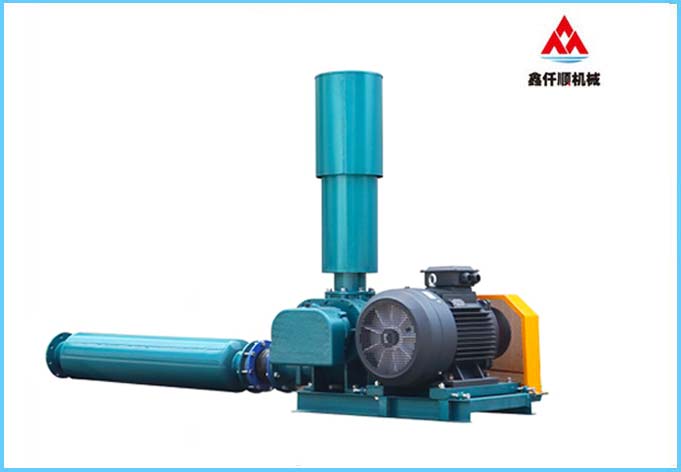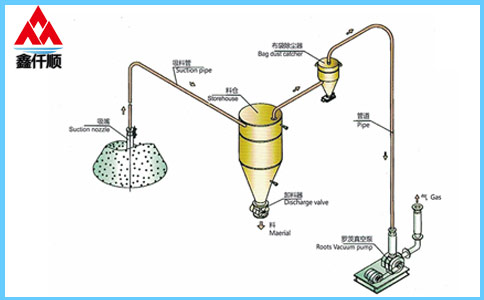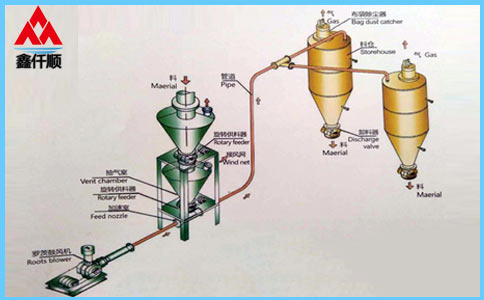Roots blower is a positive displacement air compressor, which has the advantages of simple structure, no need for lubricating oil in the fan cavity, smooth operation, stable performance, etc., and has been widely used in many fields such as petrochemical, building materials, power industry, etc. The fan is mainly composed of the body and two "8" shaped impellers. Through a pair of synchronous gears, the two rotors rotate at a constant speed in the opposite direction. The suction chamber and exhaust chamber are basically isolated by the small clearance between the impeller and the impeller, between the impeller and the wallboard, and between the impeller and the casing. The impeller blades are separated in the air inlet chamber, generating negative pressure and sucking in air; The impeller blades in the exhaust chamber mesh to squeeze the air, so as to achieve pressure rise and exhaust.
In Roots blower, the clearance between two impellers and between impeller and casing is called radial clearance, and the clearance between impeller end and plate wall is axial clearance. In order to ensure the normal operation of Roots blower, the two clearance values must be appropriate. If the gap is too large, the compressed gas will flow back through the gap, resulting in reduced fan efficiency and insufficient output; On the contrary, if the reinstallation time gap is too small, it is easy to cause the rotor to jam and the roots blower cannot operate.
With the increase of the overall temperature after the normal operation of the unit, various components will have different degrees of thermal expansion. The impeller has a relatively large volume and a large temperature rise due to being at the core of the temperature, so it has a large expansion; The wallboard and casing can be submitted relatively small, and can be cooled timely by the atmosphere when they are outside, so the expansion amount is smaller than that of the impeller. It can be seen that the axial clearance and radial clearance of Roots blower have a trend of decreasing with the increase of operating temperature.
In addition, the two impellers of Roots blower are axially positioned by the double row deep groove ball bearing at the gear end. Adjusting the relative position of the positioning bearing and the casing can realize the adjustment of the axial clearance of the impeller. It can be analyzed from the structure that under the cumulative effect of expansion, the reduction of the impeller plate wall gap at the drive end is greater than that of the impeller plate wall gap at the gear end. Therefore, attention should be paid during the assembly work to ensure that the gap between the drive end gear plate wall that can freely retract is slightly larger.
Axial clearance adjustment. This Roots blower is not equipped with an axial adjustment device for the axial positioning bearing, so it does not have the function of adjusting the axial clearance of the rotor. This defect can be solved by adding axial positioning bearing adjustment pad:
The adjusting washer with proper thickness shall be processed and assembled between the outer ring of the axial positioning bearing and the bearing seat or between the inner ring and the rotor shaft shoulder. The axial clearance between the impeller and the wallboard shall be adjusted by changing the thickness of the adjusting washer. When the gap between the impeller at the gear end and the plate wall is too large, but the gap between the impeller at the drive end and the plate wall is too small, it means that the impeller is relatively offset towards the drive end, and only needs to be replaced with a thicker washer; On the contrary, it is only necessary to grind off the corresponding thickness of the gasket.
The problem and solution of gear box crack. The oil drain plug and the screw hole of the respirator of this type of Roots blower are designed to be tapered threads, which can be compressed and sealed through thread extrusion. Its advantages are simple structure and good sealing performance, but generally it needs to use raw material belt or sealant to assist in sealing. On the one hand, the use of the raw material belt will increase the diameter of the tapered thread and increase the expansion force; On the other hand, the gear oil tank is generally made of cast iron with thin wall thickness and greater brittleness, so it is very easy to crack at the thin edge. Therefore, the problem of expansion cracks frequently occurs at the threaded hole with high stress, which seriously affects the equipment maintenance work.
Repair cracks. Since there is no significant stress at the expansion crack of the gear oil tank during operation, it can be treated by filling and bonding. After the crack is slightly filed wide on site, the metal repair agent is used to fill the crack. After the repair agent is denatured and formed, the excess burr is repaired. After reinstallation, the gear oil tank has no leakage and operates well. Similarly, welding repair can also be adopted.
Replace carbon steel drain plug with PTFE bolt. The direct cause of the gear oil tank cracking is the incompressibility of the carbon steel drain plug. The PTFE material has relatively large compressibility, and the gear tank made of cast iron can achieve good thread sealing and easy manufacturing. Therefore, PTFE bolt is a good substitute for carbon steel drain plug. After on-site replacement, there is no gear oil tank crack.
The sealing technology of taper pipe thread is changed into parallel thread. After the taper pipe thread is machined into parallel thread, the female thread hole on the gearbox only bears the axial tension stress, and there is no radial tension, so the risk of gearbox cracking can be fundamentally eliminated. For the sealing of the plug, replace the tapered thread seal with the end face pressure seal of the bolt head, and cooperate with the rubber washer or sealing rubber ring to completely ensure zero leakage. This technology will greatly improve the reliability of equipment and reduce the difficulty of maintenance, especially suitable for thin and thick lubricating oil tank structure of pump and fan equipment.
Strictly control the technical methods of maintenance. From the perspective of personnel maintenance, on the one hand, the use method of curing raw material tape: only two to three turns of winding is needed, and 1 to 2 turns of threads at the bolt end need to be exposed, at the same time, no additional thread sealant needs to be used; On the other hand, the tightening torque shall be specified: after manual tightening, the wrench shall be used to tighten it for half a turn, and excessive tightening is strictly prohibited.
Lubricating oil emulsification problems and solutions. The gearbox lubricating oil of the Roots blower is emulsified and deteriorated frequently, and needs to be replaced once a month on average, which affects the normal operation of the equipment and aggravates the mechanical wear of bearings and transmission gears. After analysis, the following leakage parts were found.
I believe that after reading the above content, you should also understand the defects of Roots blower. I hope it will be helpful to you.
Text label: Roots blower
Link to this article: //wuhanzhcs.com/html/news/n02/686.html









